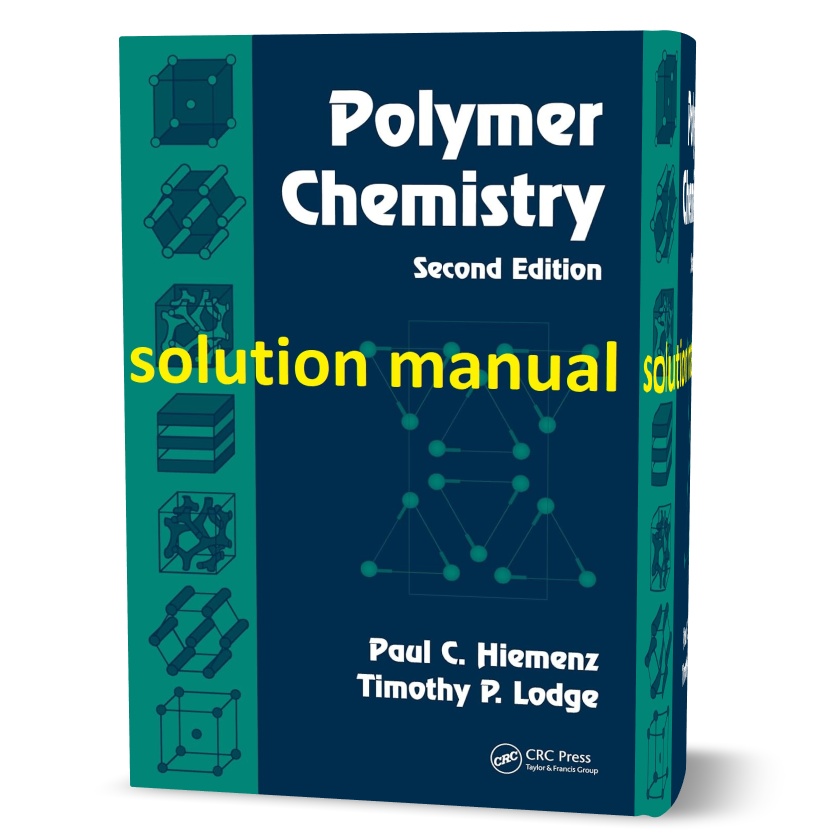


Polymer download free polymer chemistry 2nd edition by Paul C. Hiemenz – Timothy P. Lodge solutions manual pdf science is today a vibrant field. Its technological relevance is vast, yet fundamental scientific questions also abound. Polymeric materials exhibit a wealth of fascinating properties, many of which are observable just by manipulating a piece in your hands. Yet, these phenomena are all directly traceable to molecular behavior, and especially to the long chain nature of polymer molecules.The central goal of this book is to develop a molecular level understanding of the properties of polymers, beginning with the underlying chemical structures, and assuming no prior knowledge beyond undergraduate organic and physical chemistry. For download free solution manual click here.
Click Below link To Download file
Although such an understanding should be firmly based in chemistry, polymer science is a highly interdisciplinary endeavor; concepts from physics, biology, materials science, chemical engineering, and statistics are all essential, and are introduced as needed. The philosophy underlying the approach in this book is the same as that in the first edition, as laid out in the previous preface. Namely, we endeavor to develop the fundamental principles, rather than an encyclopedic knowledge of particular polymers and their applications; we seek to build a molecular understanding of polymer synthesis, characterization, and properties; we emphasize those phenomena (from the vast array of possibilities) that we judge to be the most interesting.
The text has been extensively reorganized and expanded, largely to reflect the substantial advances that have occurred over the intervening years. For example, there is now an entire chapter (Chapter 4) dedicated to the topic of controlled polymerization, an area that has recently undergone a revolution. Another chapter (Chapter 11) delves into the viscoelastic properties of polymers, a topic where theoretical advances have brought deeper understanding.
The book also serves as a bridge into the research literature. After working through the appropriate chapters, the student should be able to make sense of a large fraction of the articles published today in polymer science journals.
There is more than enough material in this book for a full-year graduate level course, but as with the first edition, the level is (almost) always accessible to senior level undergraduates. After an introductory chapter of broad scope, the bulk of the text may be grouped into three blocks of four chapters each.
the many ways in which polymers can be synthesized and how the synthetic route influences the resulting molecular structure. This material could serve as the basis for a single quarter or semester chemistry course that focuses on polymer synthesis. Chapter 6 through Chapter 9 emphasize the solution properties of polymers, including their conformations, thermodynamics, hydrodynamics, and light scattering properties. Much of this material is often found in a quarter or semester course introducing the physical chemistry of polymers. Chapter 10 through Chapter 13 address the solid state and bulk properties of polymers: rubber elasticity, viscoelasticity, the glass transition, and crystallization. These topics, while presented here from a physical chemical point of view, could equally well serve as the cornerstone of an introductory course in materials science or chemical engineering.
The download free polymer chemistry 2nd edition by Paul C. Hiemenz – Timothy P. Lodge solutions manual pdf style of the presentation, as with the previous edition, is chosen with the student in mind. To this end, we may point out the following features: ° There are over 60 worked example problems sprinkled throughout the book. ° There are 15 or more problems at the end of every chapter, to reinforce and develop further understanding; many of these are based on data from the literature.
Click Below link To Download file
برچسب های مهم